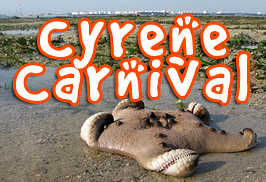Last month, when I was bringing a group of american students and professor from Semester at Sea to Pulau Ubin, somebody asked me if there were any species endemic to Singapore. Afterall, it's an island and island biogeography always speaks of endemic and rare species, unique only to the island.
However, due to our proximity to Malaysia and the fact that we were part of the Sundaland continental shelf, the evolution and distribution of species on Singapore is very similar to the rest of Sundaland which includes Malaysia and parts of Indonesia, such as Sumatra.
Although intellectually and logically, I know that there should be endemic species on Singapore, I couldn't think of a single one. Of course, since I didn't know of any and knowing that most species are shared between the two political entities, I said that "I couldn't name one of the top of my head".
Indeed, I was very glad today when Prof Peter Ng in his Natural Heritage class talked about the endemic species of Singapore! One particular crab leaves a lasting impression - the Reticulated Swamp Crab. In fact, after chasing after many people for an idea of the crab's scientific name (Parathelphusa reticulata), I finally found it mentioned on the RMBR website.
In fact the story he told in class today was more or less printed in the Royal Geographical Society's publication, Geographical, in May 2000.
"Ng's "all time favourite" discovery came in 1990. In 1988 he wrote a book on the freshwater crabs of Peninsular Malaysia and Singapore in which he recorded five true freshwater crab species from Singapore, including two endemics. "I was pretty confident I had found all the freshwater crabs there were to find on such a small island with so little forest," Ng says. "But in 1989 a student showed me a photograph of a crab from a small patch of swamp forest in the centre of the central catchment, from an area I had sampled before.Unfortunately, no photo of the reticulated swamp crab of Singapore could be found online but the image in class today will always stay in my mind.
The animal looked rather odd, with a rather unusual colour pattern, but I was rather sure of myself then and dismissed it merely as an extreme variant of a common species found there, Parathelphusa maculata. Some months later, I got a specimen of this 'variant' myself, and doubts began to surface in my mind about its presumed identity. But the specimen was a juvenile, and I had to get an adult specimen to be dead sure that it was a new species. The student and I subsequently visited the swamp many times, often in the middle of the night, to find this elusive animal; we even sacrificed our New Year's Eve in 1990 in an attempt to find specimens. They are so secretive. By day, they hide in deep burrows in soft mud and are virtually impossible to dig out. The adults only come out in total darkness in the middle of the night, especially during moonless nights, and even then, they crawl slowly in shallow streams, underneath very dense leaf litter. This behavior, coupled with their well-camouflaged colour patterns, make them almost impossible to see. We finally learned how to catch them, though, by grabbing any clump of submerged leaves that moved. As it turned out, I had been wrong. It was a separate species after all, and to beat everything, it was new to science. I named it Parathelphusa reticulata for its beautiful carapace pattern. Moreover, this species was endemic to Singapore. As later studies showed, it is found only in a five hectare patch of swamp in Singapore, and nowhere else on this planet. This is a reasonably large crab, about 35 mm in carapace width. So if something like this could have been missed for so long, heaven knows what else we are still ignorant of in the catchment. This experience was a humbling one for me - I'll never again be complacent about biodiversity, even in Singapore."
---
Edit: Duck informs me that the banded leaf monkey (Presbytis femoralis femoralis) which I am named after is actually an endemic subspecies to Singapore! How embarrassing that I did not even know this about myself. *sniffles* I must say though, we do much better on the endemic plant species front with a total of 38 (or possibly more) endemic plant species in Singapore!
To find out what other endemic species or species named after Singapore, check out this ST article by Chang Ai-lien in 2005.

 I can be contacted at
I can be contacted at 







6 comments:
See also:The Last Endemic.
Ratufa affinis affinis
Apparently, the local subspecies of lesser mousedeer (Tragulus javanicus fulviventer) and red spiny rat (Maxomys surifer) are endemic as well.
Not to mention a number of freshwater crabs.
Sometimes, I get a little sad, knowing that we have so many endemics. The risk of them being wiped out is so high...
You might wanna check out the Common Iora (Aegithina tiphia singaporensis) and the Plantain Squirrel too...
Erm, I think that when I mean endemic, I mean found ONLY in Singapore... Like the Kakapo bird can only be found in certain islands in new zealand.
I did a search for the common iora and it's found all over asia. The name for the common iora is named after singapore so that's cool :) but that's like the singapore kopsia named after singapore but can be found in malaysia too.
its really difficult because biogeographically speaking, we are so close to malaysia.
If you see the link to the ST article I included, these animals were listed there too :) Unfortunately not all are endemic but in one way or another uniquely singapore ;)
but if you want to look at it that way, the singapore rhodedendrum (sp) is named after singapore but neither endemic to singapore nor is it from singapore! haha it's from malaba O_O"
Sometimes subspecies are just really iffy but unfortunately endemic species are often subspecies. if only we have distinct species like the crab. unfortunately the catch is that the more endemic it is, the more rare, the less we know about it, the more likely it be gone soon. I totally know what you mean hai-ren.
Post a Comment